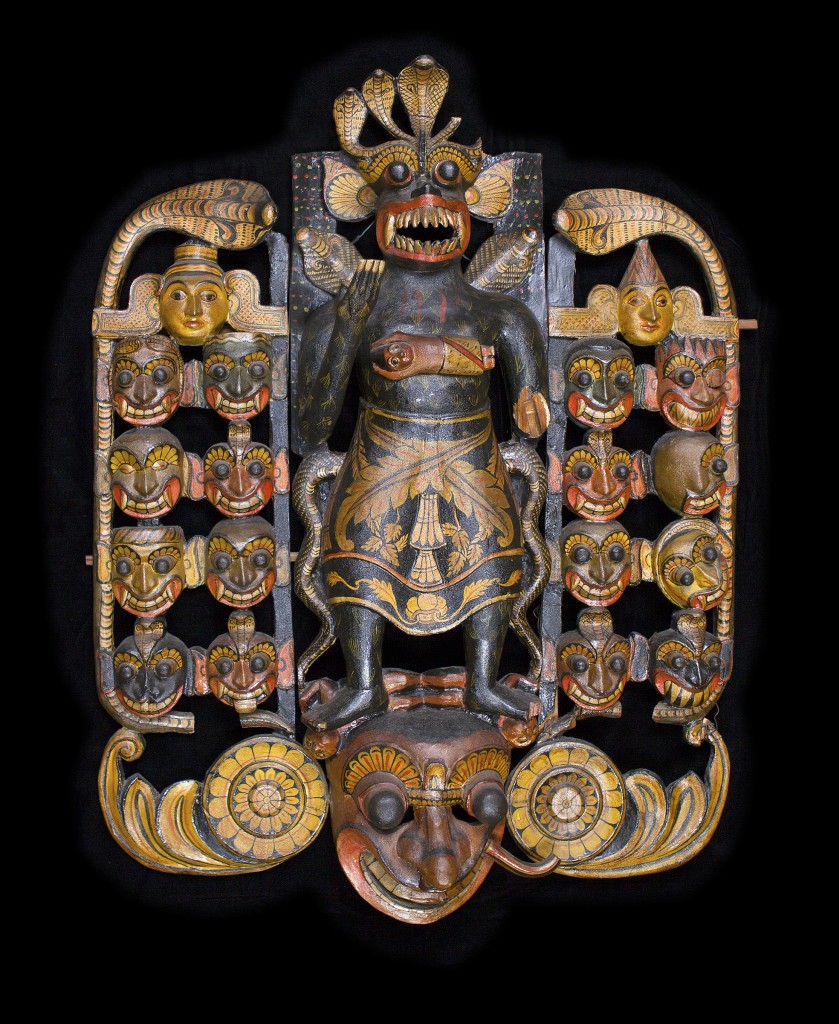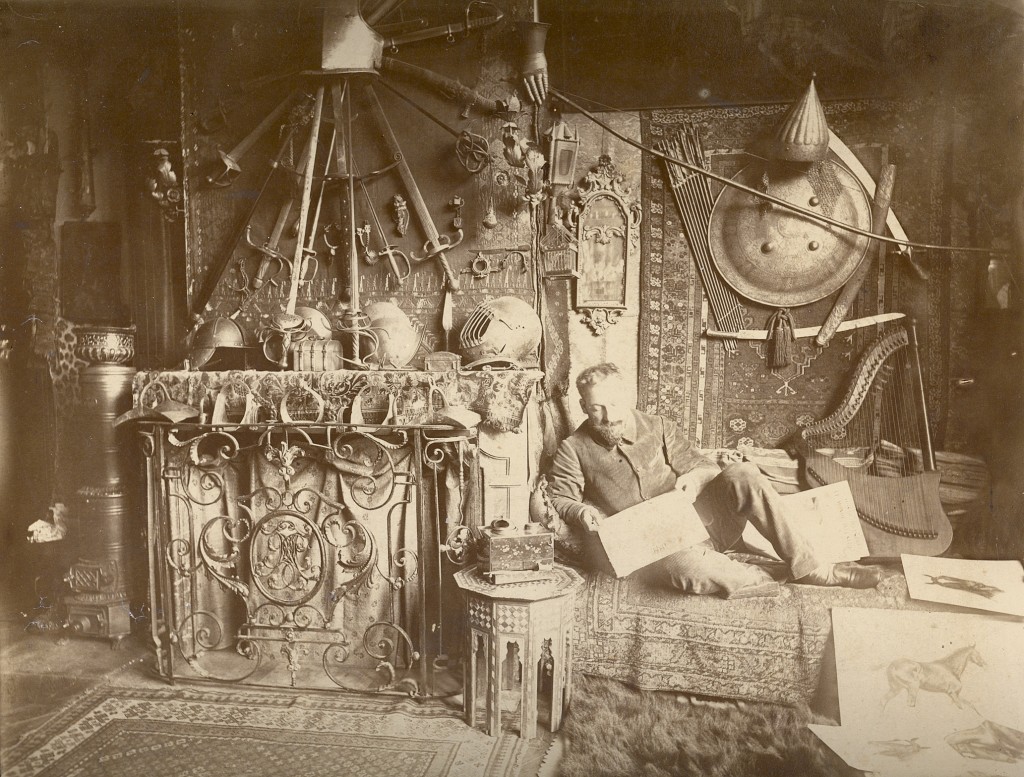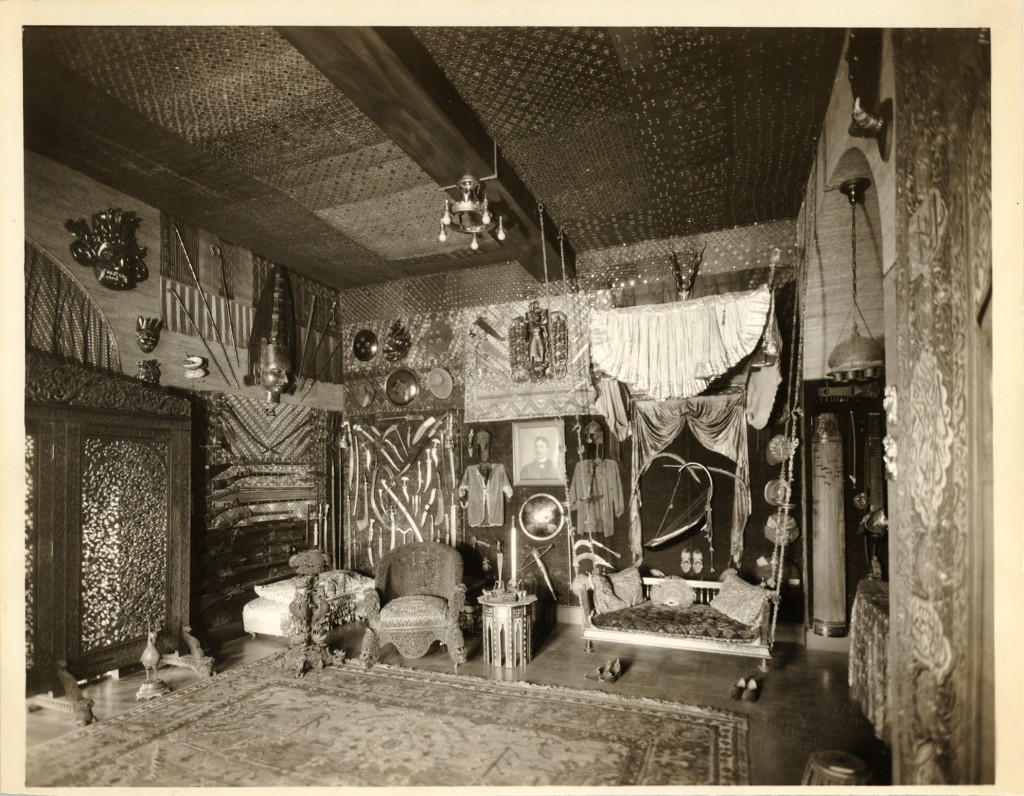 The Fleming Museum has an impressive collection of 17 Sri Lankan masks dating from the late nineteenth century, which were created for use in two ritual settings in Sri Lanka: yaktovil healing ceremonies and kolam folk dramas. The masks were brought to Vermont by two collectors, Joseph Winterbotham and Henry LeGrand Cannon. The majestic yaktovil mask pictured here, which measures 82 cm in height, was acquired by Cannon and probably dates to the late 1800s. The carved wooden mask depicts Maha Kola Sanni Yaka, chief of the sanni yakku, a group of 18 malevolent spirits who afflict humans by causing a variety of illnesses. These misfortunes are cured through elaborate night-long healing ceremonies in which ritual specialists embody the various spirits and subdue them through offerings and by dramatically representing their subservience to the power of the Buddha. Masks of this size were displayed during these ceremonies rather than put on, though a smaller mask of Maha Kola Sanniya was likely worn in the course of the ceremony. This particular mask is quite rare, with only a few examples found in museum collections around the world. The 18 spirits who are under Maha Kola Sanniya’s control can be seen depicted on either side of his face.
The Fleming Museum has an impressive collection of 17 Sri Lankan masks dating from the late nineteenth century, which were created for use in two ritual settings in Sri Lanka: yaktovil healing ceremonies and kolam folk dramas. The masks were brought to Vermont by two collectors, Joseph Winterbotham and Henry LeGrand Cannon. The majestic yaktovil mask pictured here, which measures 82 cm in height, was acquired by Cannon and probably dates to the late 1800s. The carved wooden mask depicts Maha Kola Sanni Yaka, chief of the sanni yakku, a group of 18 malevolent spirits who afflict humans by causing a variety of illnesses. These misfortunes are cured through elaborate night-long healing ceremonies in which ritual specialists embody the various spirits and subdue them through offerings and by dramatically representing their subservience to the power of the Buddha. Masks of this size were displayed during these ceremonies rather than put on, though a smaller mask of Maha Kola Sanniya was likely worn in the course of the ceremony. This particular mask is quite rare, with only a few examples found in museum collections around the world. The 18 spirits who are under Maha Kola Sanniya’s control can be seen depicted on either side of his face.
In 2008 the museum mounted an exhibition of Sri Lankan masks from their permanent collection and I had the opportunity to give a talk on the masks displayed in the exhibit, seen in the context of the healing rituals in which they traditionally play a vital part. In the course of my talk, I highlighted the theme of “framing,” the process through which we identify particular objects as the focus of our attention and define a context within which to view them and interpret their significance. Since then I have regularly brought students in my seminar on Sri Lankan Buddhism to the museum to encounter the masks, including Maha Kola Sanniya, and to reflect on the contrast between how the masks might be used in a Sri Lankan healing ritual and how they appear as objects in the museum, whether we view them as art objects or ethnographic specimens. I ask students to consider how we should frame these masks to grasp the power of their gaze and our own unconscious perspectives. What other objects should we place inside the frame to illuminate their meaning? Should we display them with examples of medical equipment, a stethoscope for example? Or would it make sense to place them within a display of theatre props? Or perhaps we should look for them amidst the great array of statues and artifacts that adorned the shelves and desk of Sigmund Freud’s study. What or whom do they represent, and how should we represent them?
A look at how the mask’s American collector, Henry LeGrand Cannon, framed this mask before it was donated to the museum provides one revealing chapter in what we can think of as the mask’s biography. Henry was the son of Col. LeGrand B. Cannon, a prominent New York transportation magnate who owned Lake Champlain Transportation and maintained a grand summer residence in Burlington (“Overlake”). The son traveled widely in South and Southeast Asia as a young man, collecting an extensive array of artifacts, which he kept in a special room in the family’s Burlington mansion devoted to his “East India curios and bric-a-brac.” Henry was also a gifted sculptor who exhibited his work in New York and at the 1893 Columbia Exposition in Chicago. This photo from the Fleming Museum shows him sitting at leisure in his “India Room”: Following Cannon’s untimely death in 1895, his collection of 600 objects was donated to the Fleming, which at that time was primarily an ethnographic collection overseen by UVM Professor George Henry Perkins, a natural historian with broad interests in human culture; Perkins instituted one of the first university courses in anthropology taught in the U.S. In 1898 a special room modeled after Cannon’s India Room (now the west wing of Torrey Hall), was constructed to house the collection. The Cannon Room continued to be very popular with museum visitors, and it was reinstalled many times, remaining largely intact even as it made the move into the new Fleming Museum, built in 1931; it remained a part of the museum until the mid-1980s when the museum underwent a major renovation. Here is a view of the Cannon Room after it was installed in the new museum, with the Maha Kola Sanniya mask prominently displayed above Cannon’s portrait:
Following Cannon’s untimely death in 1895, his collection of 600 objects was donated to the Fleming, which at that time was primarily an ethnographic collection overseen by UVM Professor George Henry Perkins, a natural historian with broad interests in human culture; Perkins instituted one of the first university courses in anthropology taught in the U.S. In 1898 a special room modeled after Cannon’s India Room (now the west wing of Torrey Hall), was constructed to house the collection. The Cannon Room continued to be very popular with museum visitors, and it was reinstalled many times, remaining largely intact even as it made the move into the new Fleming Museum, built in 1931; it remained a part of the museum until the mid-1980s when the museum underwent a major renovation. Here is a view of the Cannon Room after it was installed in the new museum, with the Maha Kola Sanniya mask prominently displayed above Cannon’s portrait: Depending upon how we frame the mask, whether as art object or ethnographic specimen, our focus shifts to different aspects of its material presence and its sensory surround. What matters is that we attend closely to its current material form, while remaining attuned to the diversity of cultural practices that have shaped its past uses, and brought it to rest today in the climate-controlled security of the museum’s storage facility. My thanks to the Fleming for preserving this precious object for over a century, giving us the opportunity to view it within multiple frames and from various points of view.
Depending upon how we frame the mask, whether as art object or ethnographic specimen, our focus shifts to different aspects of its material presence and its sensory surround. What matters is that we attend closely to its current material form, while remaining attuned to the diversity of cultural practices that have shaped its past uses, and brought it to rest today in the climate-controlled security of the museum’s storage facility. My thanks to the Fleming for preserving this precious object for over a century, giving us the opportunity to view it within multiple frames and from various points of view.
